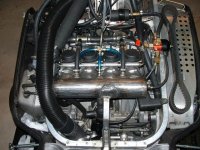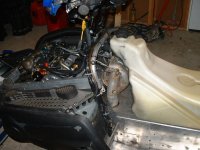rideblue
Expert
- Joined
- Mar 17, 2005
- Messages
- 223
- Reaction score
- 0
- Points
- 466
- Location
- Buena Vista Colorado
- Website
- www.mountaintechbv.com
Is it possible for the volume of the charge tube, plenum and intercooler to be too small to allow CV carbs to function properly? In other words, can the air space from the turbo to the carbs be too small, letting boost build quicker that the carbs can adjust for?
My carbs, BOV, charge tube, plenum, fuel system, turbo, etc. have no leaks and are in good working condition. It will run great up till about 1/3 throttle (7000rpm) makes 2-3 pounds of boost, and any more than 1/3 and boost will rise up to 8 PSI but sled runs like crap. EGA will indicate a lean missfire one time and than read rich the next time. EGT's drop when either happen. Main jets and needle clip changes have little or no effect on the condition. EGA reading done at the shop (8000 ft), and at parking lot (9500 ft), but not while riding at 10,000 - 12,000 ft.
I can unhook charge tube, rejet and install stock air box, and it runs great. So there should not be any electrical or mechanical issues causing this. Any ideas????????????
IHI RHB52 VF-4 spec turbo (1.8 l subaru), 45 PSI pump, Aeromotive fuel pressure reg, Bosch BOV (Saab)
My carbs, BOV, charge tube, plenum, fuel system, turbo, etc. have no leaks and are in good working condition. It will run great up till about 1/3 throttle (7000rpm) makes 2-3 pounds of boost, and any more than 1/3 and boost will rise up to 8 PSI but sled runs like crap. EGA will indicate a lean missfire one time and than read rich the next time. EGT's drop when either happen. Main jets and needle clip changes have little or no effect on the condition. EGA reading done at the shop (8000 ft), and at parking lot (9500 ft), but not while riding at 10,000 - 12,000 ft.
I can unhook charge tube, rejet and install stock air box, and it runs great. So there should not be any electrical or mechanical issues causing this. Any ideas????????????
IHI RHB52 VF-4 spec turbo (1.8 l subaru), 45 PSI pump, Aeromotive fuel pressure reg, Bosch BOV (Saab)

 carburation...
carburation...


